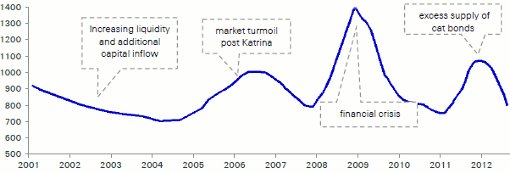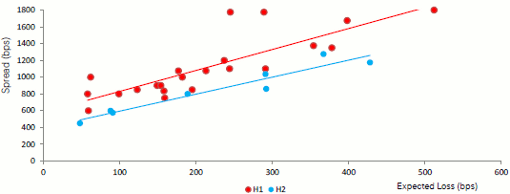2012 has been an interesting year as far as transaction pricing and the spreads of outstanding catastrophe bonds and insurance-linked securities have developed. Spreads of new cat bond transactions have been tightening throughout the year and this is a trend that reinsurer Swiss Re said would likely continue into 2013 at their recent insurance-linked securities (ILS) media event at their London offices.
Cat bond and ILS spreads and pricing have always tended to fluctuate driven by a number of factors including supply and demand, availability of capital within the reinsurance convergence space and traditional reinsurance pricing trends. Since the market began we’ve seen spreads change direction a number of times.
As the cat bond and ILS market became an accepted component of the reinsurance risk transfer market, and participants and investors became better educated on the use of what were novel financial instruments, spreads went through a period where they steadily decreased. As the market grew, liquidity increased, number of participants increased and additional capital flowed into the ILS space helping spreads reduce further.
Then spreads, particularly for U.S. wind, took a hit after hurricane Katrina caused huge reinsurance market losses and some nervousness among cat bond market participants, investors and sponsors. This rise in spreads lasted around a year before they started to decline slowly again. Then the global financial crisis caused cat bond and ILS spreads across the board to spike considerably, not helped by the impact of the failure of Lehman Brothers who at the time played a key role in a number of cat bond transactions.
That spike in 2009 didn’t last so long and the market came to terms with the new post-crisis situation much quicker than previous spikes in cat bond spreads, perhaps showing increasing levels of maturity and understanding among investors and market participants. Spreads steadily dropped back to pre-crisis levels by 2011 but then we saw a capacity crunch in early 2012 which caused a spike in spreads once again.
The spike this year has been well documented, not least by us in our regular updates on secondary cat bond price indices, it was caused by high levels of primary cat bond issuance created a capacity squeeze resulting in a jump in secondary market prices causing spreads to go up. This trend lasted a few months until new capital flowed into the sector, primary issuance slowed a little and this helped spreads to drop.
The trends Swiss Re discussed are well illustrated by this graph showing the peaks and troughs of the spreads on primary issuance of U.S. wind cat bonds from 2001 to the present.

Illustrative spreads of primary U.S. wind cat bond issuance January 2001 to December 2012 - Source: Swiss Re Capital Markets
The change in spreads seen in 2012, as capital helped to reduce them after the capacity crunch was overcome, are evident in the spreads of U.S. hurricane cat bonds issued over the course of the year. During the capacity shortage spreads for U.S. wind were higher, once capital flowed into the space the spreads noticeably reduced in issuances through the rest of the year. On average spreads for U.S. wind exposed bonds reduced by as much as 20% in the second half of 2012 and Swiss Re highlighted that this has continued post-Sandy. Non-U.S. wind risk is also pricing at tight levels as investors seek out diversification opportunities.

Spreads of U.S. wind cat bond issuances in 2012 - Source: Swiss Re Capital Markets
Swiss Re said that spreads are now approaching their historic low-level last seen in 2004/2005 before hurricane Katrina struck the U.S. This continued tightening of spreads seen through 2012 has helped pricing of new ILS and cat bonds reach the point where by it has now converged with traditional reinsurance cover, according to Swiss Re.
Swiss Re expects spread tightening will continue, and volatility in spreads will be reduced going forwards, as more capital enters the ILS and cat bond market helping to avoid any near-term capacity shortages and any future spikes in spreads. They expect inflows of capital will help to keep the demand for cat bonds high, putting pressure on spreads and keeping pricing converged with reinsurance. With the market becoming better balanced Swiss Re hope that demand and supply characteristics will help to smooth spreads over the longer-term. Of course the spreads will still fluctuate to some degree, but likely in line with traditional reinsurance rates which will help to keep cat bonds and ILS a cost-effective alternative for many sponsors.
Read our other articles covering Swiss Re’s recent media event:
– 2012 see’s catastrophe bond market return to growth: Swiss Re
– Cat bond market can expand with new perils and regions: Swiss Re
 View all of our Artemis Live video interviews and subscribe to our podcast.
View all of our Artemis Live video interviews and subscribe to our podcast.
All of our Artemis Live insurance-linked securities (ILS), catastrophe bonds and reinsurance video content and video interviews can be accessed online.
Our Artemis Live podcast can be subscribed to using the typical podcast services providers, including Apple, Google, Spotify and more.































